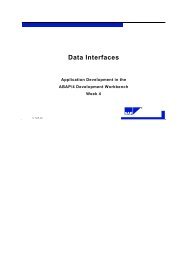business continuity institute good practice guidelines 2007
business continuity institute good practice guidelines 2007
business continuity institute good practice guidelines 2007
Create successful ePaper yourself
Turn your PDF publications into a flip-book with our unique Google optimized e-Paper software.
Page 9<br />
Business Continuity Management GOOD PRACTICE GUIDELINES <strong>2007</strong><br />
organisation.<br />
• Recovery Point Objective (RPO) - is the point to which information must be restored to<br />
enable an activity to operate once it is resumed.<br />
Terminology ‘Critical’ activities<br />
• Having ascertained the MTPD for each activity it is often convenient to link activities with<br />
similar recovery requirements. Sometimes organisations call these groups according to<br />
the recovery timescale (e.g. 1 day, 2 day, 1 week etc); others use the term ‘critical’ (or<br />
‘mission critical’ activities) for those activities required within the first few days.<br />
Unfortunately for those unfamiliar with BCM terminology, ‘critical’ is often interpreted as<br />
‘important’ leading to misunderstandings when collecting data for the BIA and the,<br />
incorrect, assumption that recovery tactics and plans are not required for ‘non-critical’<br />
activities. Terms with less ambiguous, time related meanings in general use include<br />
‘time-critical’, time sensitive and ‘urgent’.<br />
Assumptions<br />
• It is assumed that the organisation can be understood by analysis of separate <strong>business</strong><br />
activities<br />
• The MTPD may be difficult to determine for seasonal or periodic functions such as yearend<br />
processing and projects. In such instances impact analysis should focus on an<br />
interruption to the activity during one of these peaks<br />
• Where resilience measures are already in place these should be assumed to be in<br />
operation (though they may prove not to be adequate)<br />
Sensitivity of information<br />
• It is possible that some information will be market / industry sensitive and so in some<br />
organisations it will not visible to the BCM professional. Not having this information<br />
should not stop the BIA activity being undertaken but may prejudice the accuracy of the<br />
end results.<br />
5. Process<br />
Scope and Scale<br />
• If the organisation is part of a group – identify the relationship between the various parts<br />
of the organisation since this may affect the MTPD<br />
• If the organisation has multiple locations identify the geographical scope of the BIA from<br />
the Policy.<br />
• Sign off the terms of reference with the project sponsor drawn from Executive or Senior<br />
Management Group<br />
Version <strong>2007</strong>.2 15th March <strong>2007</strong> © The Business Continuity Institute <strong>2007</strong>
















